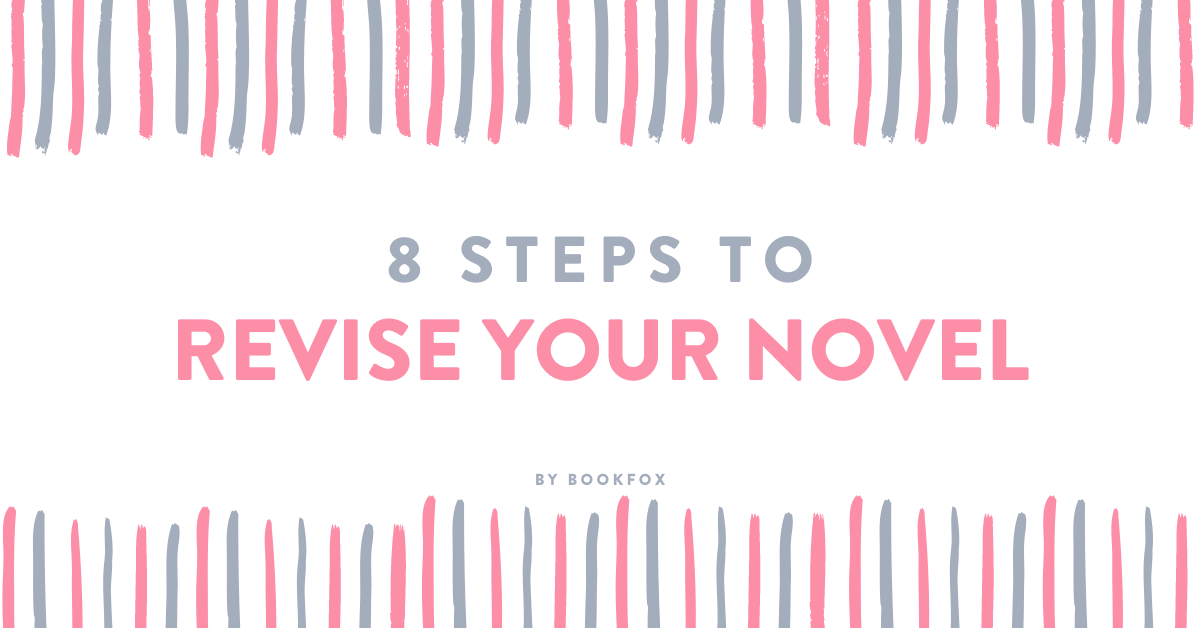 Revision is painful. When I sit down to revise, I find I would rather be doing anything else: scrubbing the toilet, doing taxes, scooping my own eyeballs out with a spoon — whatever.
Revision is painful. When I sit down to revise, I find I would rather be doing anything else: scrubbing the toilet, doing taxes, scooping my own eyeballs out with a spoon — whatever.
Anything to avoid the act of revisiting the first draft.
I dread revision because it’s an overwhelming process. There’s so much to fix. And, on the hardest days, insecurities percolate. The changes I make feel all wrong. “The magic is over. Give it up, kid!” I say, as my fears fester.
But with a plan for revision, I can overcome my insecurities and rally toward a better draft. First, I focus globally on big picture components of the manuscript: plot, genre, and character. Then, I wheedle my way down to local revisions that focus on language and word choice. I’ve listed eight steps for revision in this post. So, you can approach revision with top-to-bottom, manageable tasks, and you’ll stay on course to complete your best draft.
So, let’s make changes, shall we?
1. Distance Yourself from Your Story.
 Let the story air out for a few weeks or months.
Let the story air out for a few weeks or months.
Promise yourself you won’t even sneak a peek at your manuscript pages. Work on something else. Because if you try to revisit your work while the words are still tattooed on the undersides of your eyelids, you won’t see what’s working and what’s not.
Adjust your focus.
While you are taking a break from your novel, dabble in a different genre. Do some world work for a story that came to you in the middle of your current manuscript. Or, read the pile of books accumulating on your desk. Do something to vacate your current head space, because you want to come back to your novel with the freshest eyes possible.
Do a read through.
After your sabbatical, sit down and read your manuscript. Try to read it all in one whack, if possible, or in long bursts over a series of consecutive days. At this point, don’t come at the draft with any pre-ordained revision ideas. Instead, take advantage of your clear head and your ability to see what you had missed before. Make notes in the margins. Note the passages where your mind wanders, and pay attention to your reactions at each plot event.
2. Fix Plot Holes

Outline.
Sometimes it’s helpful to outline after your draft is written. If your story is choppy and drooping in the middle, try a high-level outline. Capture the main idea of each chapter or chunk of your novel. If a passage, chapter, or an entire story chunk seems to diverge or stall momentum, it’s safe to rework. The high-level outline may also reveal what’s missing from your story’s structure. Perhaps character motivations are unclear. Perhaps the conflict is not enough to move the story forward. Whatever the case, an outline will help you mold the overall shape of your story.
Use a graphic organizer.
If outlines are not for you, try a different approach to organizing your thoughts. Sometimes, my visual brain shirks a numbered, bulleted list. In this case, a graphic organizer can work magic. A bull’s eye, a pictographic timeline, a sequence chart, a Venn diagram, a three-act concept map — all of these can be as beneficial as an outline.
Work from a central theme, sentence, or question.
If your draft is too long or meandering, try working from a central idea. When a passage does not fit with this central idea, in at least some tangential way, it needs a cut or rework. When your decision maker is over tired and unreliable, let your central idea guide you.
Welcome change.
Let the shape of your novel change drastically if it needs to. The word revision, broken down to its essential parts (re + vision), means to see again. So if you are seeing the story in a new light, the structure, point of view, or world where your novel takes place may morph completely. Maybe the first half of the book gets chopped.
Maybe you keep only ten of the best sentences from the first draft. The point is, writing is re-writing, and just because you’ve worked incredibly hard on draft one does not mean every passage, chapter or character of draft one deserves to travel to draft two.
“Kill your darlings.”
“Kill your darlings,” said Sir Arthur Quiller-Couch… and William Faulkner… and also Stephen King. “Killing your darlings” refers to the practice of cutting the story parts that read beautifully, but don’t fit. Chop these passages out and put them in a re-work pile. Do not hang on to them simply because they sound gorgeous.
It’s possible these passages will work themselves back into your novel, and it is possible these passages will birth new stories all their own. It is also possible for these darling pages to live forever in a folder on your desktop titled “Beautiful Parts that Just Don’t Work.” And that’s okay, too. Accept what’s broken and move on.
Work on pacing.
Pacing is all about keeping readers engaged. Writers create good pacing by building tension through character conflict. To ratchet tension, focus on the structure of your chapters; Does each chapter contain conflict? Are some chapters miles long while others contain only a few paragraphs? Have you created a scene that could instead be a summary or vice versa? Asking each of these questions will help you maintain your story’s momentum.
Find the most effective beginning.
You know the feeling, when you’re reading the opening pages of a book, and you wonder, “Am I ever going to get into this book, or is it going to live under a dusty veil on my bookshelf?” And then BAM, twenty pages in, the story starts to live, take shape, and feel more habitable. Often, this phenomenon happens because the writer is especially precious about opening pages.
I am guilty of going over and over opening lines until my eyes are bleeding. And usually, I’m not making the opening lines better. I’m convoluting with unnecessary literary flourishes and fancy phrasing that doesn’t exist in the rest of the story. The beginning (the actual beginning) of my story is buried somewhere in these first twenty pages.
To combat an overwrought beginning, hunt for the juicy detail, the betrayal, the lethal decision, and put this moment up front without the fancy phrasing.
Revise the end.
Many, many endings fall flat initially. Often, a draft ending is a sentimental phrase or a fortune cookie-esque statement. This kind of ending is not satisfying for a reader. But, you can use your fortune cookie statement as a seed bed. What concrete scenes and images grow from your unsatisfying ending? Ending with a scene will turn an abstract statement into an actual picture, and your ending lines will become more impactful.
Ask yourself, does it feel true?
By virtue of our chosen genre, we are writing made up stories. But, even fiction incorporates the truth. Most stories, no matter how fantastical, contain people, places, and events from the author’s life. For instance, Stephen King’s It included The Barrens, a vacant lot where the characters played.
This lot reappeared in many of King’s novels, and it was based on an actual place from his childhood. Only difference was, King and his friends referred to this place as “The Jungle.” So, if it feels like a character’s actions or words are phony, incorporate a non-fictional experience. Find your jungles, and the characters who play in them. Now, does the story feel authentic?
3. Attend to the Features of Your Genre

Identify your genre and deliver.
Every reader comes to a book with expectations. If your reader is in the market for a horror novel, they expect a scare, some gore. If readers buy a romance novel, they want a steamy relationship.
If someone sits down to read a mystery, they’re hoping to gather clues, make inferences, and resolve a case. If these expectations are not met, readers feel duped. This is not to say your genre novel should follow a stereotypical pattern.
This is to say, know what you are writing and meet the needs of your reader. If you are not sure whether you have written a romance or a crime thriller, there is a choice to be made and plot work ahead.
Read widely in your genre.
Some writers swear off reading in their genre in an effort to maintain originality. But often, before taking on a project, agents want to know what new, fresh angle your book offers. How will you ensure you have written an innovative angle if you have not read widely in your chosen genre?
Novels in your genre also function as teachers. When you read these books like a writer, you are able to identify plot patterns, cliches, and elements worth emulating in your own work. So read on!
Make old new again.
Every genre includes its tropes.
Horror is rife with zombies, speculative fiction loves corrupt governmental institutions, and try to name a recent, popular sci-fi free from artificial intelligence of some kind. If you are a genre writer, your novel will likely include a common, genre-specific trope. The challenge here is finding a way to write these tropes with originality. So, the revisionist’s question is, have I seen this before? Am I bringing new ideas to the genre, or am I regurgitating tales of old?
Rebuild your world.
In the initial draft, you might get lost in building your world. When I was younger, I loved playing The Sims because I loved building their houses, constructing their gardens, and placing their furniture. I spent all of my time on this component of the game, and when it came to having The Sims interact and thrive in their world, I didn’t care. I see this old penchant of mine emerge in my initial drafts.
I get so carried away in describing elaborate scenes and building fantastical new realities, I forget about the story and the protagonist’s development. The end result is pages and pages of world building that contain no momentum, plot design, or character arc. Often there are nuggets of genius in these pages.
But the only remedy for over-building a world is to make cuts. Put your cuts into a separate pile. And when you are carving out plot, look for opportunities to organically infuse your best world building sentences.
4. Add Layers of Meaning to Characters:
 Redevelop characters into multidimensional beings.
Redevelop characters into multidimensional beings.
In the beginning, every character I write is me, or some version of me. Or worse, the character is a background element flat as paper. In each case, I need to add new dimensions to the character, or else cut them out. To flesh out personas, some authors fill out elaborate questionnaires.
Others build character files thick with pictures, totems, diplomas and landscapes reminiscent of the character’s life. Other writers create playlists unique to each character and only listen to that playlist when they are writing that character.
I use a sketch book and do literal character sketches. While I’m drawing a scar above the character’s eyebrow or a smattering of freckles across the bridge of their nose, I develop the character’s story. If you find that your characters are flat, try rewriting them with one of these development techniques.
Enhance Character Arcs.
Another way to enhance characters is to revise their arc. For readers to invest in a story, they need to root for your characters. And a reader cannot root for a person who isn’t changing or growing.
If your character isn’t undergoing or inciting some kind of change over the course of your story, it’s time for revision. One sure-fire way to check character arc is to read the character in isolation. Focus only on passages including the character you want to adjust. Does the character’s development feel organic in relation to the plot points? Or does the character’s arc feel abrupt and unfounded?
Be specific about what your characters are doing and feeling.
In my first drafts, I find many, many passages studded with vague, sweeping statements. Take this sentence, for instance: Happiness was unfamiliar. Because this sentence is so abstract, readers have difficulty grasping its meaning. To fix it, I need to tether the abstract parts (feelings and motivations) to more concrete moments.
So, happiness was unfamiliar becomes Smiling was unfamiliar to Mia, and after so many minutes of laughing, her cheeks twitched. By naming the character and tying her emotions to relatable bodily responses, readers get a clearer understanding of the intent behind this sentence.
Humanize characters.
The reader roots for the protagonist (hopefully), but that does not mean the protagonist has to be a good guy all the time. To sustain reader’s interest, your characters must maintain the potential to lose. So, highlight the protagonist’s weak points. Let your character fail, and tell us about it. Likewise, villains or antagonists (in life and in books) are not 100% terrible.
By humanizing your antagonist, they become less stereotypical, and the story takes on new depth.
5. Reconstruct Scenes into Powerful Moments
 Focus on setting.
Focus on setting.
A well-developed setting rips readers out of their world and into the story. But, an undeveloped setting may leave characters and plot events feeling floaty. Questions to ask as you’re rewriting setting include: Have you established a sense of place and does it move your characters where they need to go? Does the setting amplify suspense? Are there reoccurring symbols contributing to the book’s overall theme?
Limit exposition in favor of scene.
In college, I took a creative writing class where one of my stories was highly critiqued for “containing too much exposition.” In front of the class, my instructor drew a single pencil slash through half of my story. The graphite cut like a sword.
I was embarrassed, but the instructor was right, my first pages were just scaffolding for what I needed to write: a scene. In early drafts, where writers are struggling to wrangle so many story elements simultaneously, they often miss opportunities to create scenes. Instead, writers cram in long explanatory segments (exposition) to help themselves put down a first draft. To fix this, highlight scenes in one color and highlight exposition with another.
This color-coding system will illuminate exposition-heavy areas of your novel, and you’ll be able to identify where to build new scenes.
Harness the power of the five senses.
Look for scenes you’ve summarized or “told.” Would the story benefit if the scene was expanded into a more immersive experience? If so, try re-writing the scene with a focus on the five senses. What are characters seeing, hearing, tasting, touching/feeling, and smelling? If you are not sure what your characters might be sensing in a given scene, do “world-work.”
If your novel takes place in Siberia, get as close to Siberia as you possibly can. If you can’t get on a plane and visit the Arctic tundra, call someone who has visited. Scour YouTube channels about Siberia, pour over Google images, stick your face in the freezer — do whatever you can to inhabit the setting for yourself, and write what you sense.
Reduce doing-nothing scenes.
Look for one-note scenes and figure out how to make them more complex, efficient, and interesting. Ideally, a scene will pull double or triple duty; the scene will develop characters and move the plot and establish the setting.
One way to identify lazy scenes is to find moments where characters are sitting around having a chat. Are characters dialoguing on a couch, or sitting idly in a car? Maybe the character’s discussion is vital, but why not allow a plot event or setting develop around this conversation?
Can the characters have the same talk while an action is occurring? Conversely, a lazy scene might be a lengthy world-building passage. In this case, could you insert more character action?
6. Experiment with Tense and Point of View
 Make tenses consistent.
Make tenses consistent.
Will you write in present tense, past tense, or (for the more avant-garde) future tense? Whatever you choose, be sure to stick with the same tense throughout your novel. If you’ve accidentally slipped into present tense for a chapter or two, be sure to adjust these passages accordingly. Deliberate tense shifts can and do exist, but they are rare, and you’ll want to ensure any shift serves your work in the best way possible.
Revise tense.
A story can take on new life when you revise tense globally. Try shifting a first draft written in past tense entirely to present tense (or vice versa). Both tenses offer benefits. Present tense novels give readers the feeling of participating in the action as it unfolds. Readers get the sense that whatever is happening is happening now. This sense of immediacy can create a tour-de-force feeling and keep readers turning pages.
But novels written in past tense have advantages, too. Novels in past tense offer more malleability with time and reflection. Also, past tense novels allow writers to ratchet tension in situations where a character’s history, or perhaps history at large, affects unfolding events. Which tense better serves your story?
Alter point of view.
Point of view concerns who is telling the story. There are many ways to alter a novel’s point of view. The story might be told in first person, second person, epistolary form, third person closed, third person limited, or third person omniscient. You might have an alternating point of view shifting between different characters. You might have a wacky point of view character — maybe an animal or an inanimate object tells the story.
Whatever the case, point of view offers a chance to make your story unique. After I’ve written a story and nailed down plot and character arcs, I like to take a passage or two and experiment with point of view. If the story is about a mother-daughter relationship it might be interesting to alternate points of view between mother and daughter.
If a character is a gambling addict, it might be interesting to let the casino chips do the talking for a chapter or two.
7. Get Help
 Find a critique group.
Find a critique group.
If you are unsure about the direction of your next revision, it’s time to assemble a critique group. Writer groups are all over social media, in your local recreation centers, coffee shops, and church basements. Or you can find creative writing services that offer classes and critique packages. In any case, find other writers to read your work and provide feedback. The best feedback identifies incongruous, boring, and confusing moments in your draft.
Reader feedback might be prescriptive: “You could fix this by doing ____ and ____.” But, ideally your critiques will not be too prescriptive.
You can direct your feedback for revision (e.g., please focus on story structure, or character arcs, or creating vivid scenes), and because your group includes other writers they’ll have a better idea of what’s broken and why.
Find beta readers.
These readers don’t have to be writers. Maybe they are your spouse. Or your kid. Or your best friend. As long as they like to read, and they are willing to help you out, they’re fit for the job. In this case, you’re looking for readers’ reactions. Did they react to the moments they were supposed to and how you wanted them to? Or are readers unengaged, offended, or befuddled?
Keep a discerning mind.
It’s important to keep an open mind and consider all angles, but if a critic seems to provide harried feedback based on a misread or overtly prescriptive advice, they might be missing the point and steering you in the wrong direction. Accept what works for your story.
Rewrite apart from your manuscript.
Some of the best advice I’ve ever gotten from an editor was to rewrite away from my draft. Once you’ve identified your problems, don’t attempt the rewrite in your already marked up manuscript. Open a fresh document and free write toward your critique for twenty minutes. Give yourself the space and time to work out the problem without worrying about connective tissue. See what happens.
Develop a draft for a larger audience.
The pressure of publication can take your draft to the next level. After you’ve had your critique group read through your draft, and you’ve finished a round or two of revisions, try making a chapter into a stand-alone short story. By honing a chapter into a short story, and submitting it to a literary journal you’ll find yourself in a revision whirlwind.
Suddenly, the pressure to make the chapter its best self is fully palpable. And, if this segment of your work is chosen for publication, you open yourself up to a whole host of benefits, including the experienced eye of an editor. You might also build an audience before your book in progress hits the shelf. This audience may even include inquiring agents.
8. Hone Language
 Harness the power of your reviewing software.
Harness the power of your reviewing software.
Reviewing software doesn’t catch everything. But, find and replace can be a godsend when it comes to searching out your writerly bad habits. For instance, one of my tics is beginning a sentence with a conjunction. I do this with an annoying frequency, but if I search and replace And, Because, But, and so on, I can cut down the number of times I rely on this convention.
Read aloud to assess the sound.
After reading your work one thousand times, it becomes difficult to see the mistakes. Your brain skips over the flaws, filling in the missing words or ignoring the filler sentences and clunky moments. But, reading aloud forces your brain to slow down and identify each word. Also, if you find you are out of breath or your mind is wandering during your read aloud, it could mean a passage requires a re-work.
Get rid of say-nothing words.
You’d be surprised by how many words say nothing at all. Somehow, I wondered, I thought, that, just, start, begin — all of these words and phrases can be replaced with stronger substitutes or eliminated entirely. For a comprehensive list of say-nothing words, check here.
Vanquish to-be verbs.
To be verbs (is, are, am was, were, be, being, been) cause writers to use more words and offer diluted pictures. Consider this example: She was looking over the fence. If we replace the to-be phrase was looking with an active verb, we get a more efficient sentence and a clearer picture: She peered over the fence.
Eliminate passive voice.
Consider this example of passive voice: The TV was flicked on by John. Because this sentence is written in passive voice, I’m left to wonder, who turned on the TV? Was it a ghost? An electrical malfunction? A person?
By attributing the action to a subject we get a clearer picture: John turned on the TV. Unless the passive voice is a deliberate stylistic function, identify who or what is executing each action to avoid any reader confusion.
Cut unnecessary adjectives and adverbs.
A paragraph rife with adjectives and adverbs creates a muddy picture and leaves your reader trying to imagine an impossible scene that is somehow dark and lovely and dank and lively and crunchy and soft and bathed in light. Pick one or two adjectives to illustrate what you wish to say. Instead of pumping up descriptive words, try upping your verb count. Punchy, evocative verbs create an action-packed page and create crisp images.
Revise dialogue tags.
Once you give an initial round of attributions in a given dialogue scene (said Sarah and said Marco), you don’t have to continue giving those attributions. if your characters are aptly developed, tagging their speech over and over within the same scene is tiresome. Instead, try giving body language cues or interruptions involving the current scene. Whatever the case, don’t overdo it. Make sure the conversation and the scene intermix naturally.
Use the power of negative space.
This one isn’t about language; it’s about the absence of language. If you notice you have impenetrable blocks of text — a singular paragraph spanning pages and pages— it’s time to include negative space. Blank space gives your reader a breath and a moment to solidify their understanding. You can create blank space with section breaks, moments of dialogue, or by breaking larger paragraphs into smaller paragraphs.
Focus your attention at the ends of sentences.
Invariably, my first draft is rife with sentences ending in prepositions: She peered over the fence to determine which room the old man was hiding in. Ending in a preposition is a dead end. Ending with an action, instead of a preposition, is much stronger: She peered over the fence to determine where the old man was hiding.
Don’t give up.
Whatever you do, keep going. Writing is more about dogged pursuit than about talent. When a passage is clunky, keep going, when it’s your eleventh draft, and you’re rejected, keep going. When a critique group tears apart your draft keep going. Keep going. Keep going!

2 comments
When I played Sims I always just chose a pre-made house and got right into the game play. With my writing, I often lack setting and move right into dialogue and character interaction. This comparison really opened my eyes to how my brain works!
This is the best group of suggestions I’ve seen so far. Kudos.
I’ve just finished my first draft of my first novel of 110,000 words, in what I believe would be called magical realism genre. Thank you for the thoughtful and comprehensive ideas.